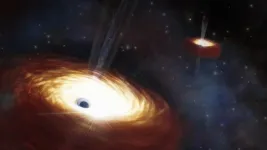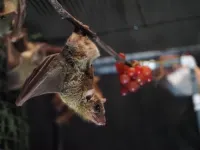(Press-News.org) Nearly every massive galaxy hosts a supermassive black hole at its center. When two galaxies merge, their black holes can form a binary pair, meaning they are in a bound orbit with one another. It’s hypothesized that these binaries are fated to eventually merge, but this has never been observed [1]. The question of whether such an event is possible has been a topic of discussion amongst astronomers for decades. In a recently published paper in The Astrophysical Journal, a team of astronomers have presented new insight into this question.
The team used data from the Gemini North telescope in Hawai‘i, one half of the International Gemini Observatory operated by NSF’s NOIRLab, which is funded by the U.S. National Science Foundation, to analyze a supermassive black hole binary located within the elliptical galaxy B2 0402+379. This is the only supermassive black hole binary ever resolved in enough detail to see both objects separately [2], and it holds the record for having the smallest separation ever directly measured — a mere 24 light-years [3]. While this close separation foretells a powerful merger, further study revealed that the pair has been stalled at this distance for over three billion years, begging the question; what’s the hold-up?
To better understand the dynamics of this system and its halted merger the team looked to archival data from Gemini North’s Gemini Multi-Object Spectrograph (GMOS), which allowed them to determine the speed of the stars within the vicinity of the black holes. “The excellent sensitivity of GMOS allowed us to map the stars’ increasing velocities as one looks closer to the galaxy’s center,” said Roger Romani, Stanford University physics professor and co-author of the paper. “With that, we were able to infer the total mass of the black holes residing there.”
The team estimates the binary’s mass to be a whopping 28 billion times that of the Sun, qualifying the pair as the heaviest binary black hole ever measured. Not only does this measurement give valuable context to the formation of the binary system and the history of its host galaxy, but it supports the long-standing theory that the mass of a supermassive binary black hole plays a key role in stalling a potential merger [4].
“The data archive serving the International Gemini Observatory holds a gold mine of untapped scientific discovery," says Martin Still, NSF program director for the International Gemini Observatory. "Mass measurements for this extreme supermassive binary black hole are an awe-inspiring example of the potential impact from new research that explores that rich archive.”
Understanding how this binary formed can help predict if and when it will merge — and a handful of clues point to the pair forming via multiple galaxy mergers. The first is that B2 0402+379 is a ‘fossil cluster,’ meaning it is the result of an entire galaxy cluster’s worth of stars and gas merging into one single massive galaxy. Additionally, the presence of two supermassive black holes, coupled with their large combined mass, suggests they resulted from the amalgamation of multiple smaller black holes from multiple galaxies.
Following a galactic merger, supermassive black holes don’t collide head-on. Instead they begin slingshotting past each other as they settle into a bound orbit. With each pass they make, energy is transferred from the black holes to the surrounding stars. As they lose energy, the pair is dragged down closer and closer until they are just light-years apart, where gravitational radiation takes over and they merge. This process has been directly observed in pairs of stellar-mass black holes — the first ever recorded instance being in 2015 via the detection of gravitational waves — but never in a binary of the supermassive variety.
With new knowledge of the system’s extremely large mass, the team concluded that an exceptionally large number of stars would have been needed to slow the binary’s orbit enough to bring them this close. In the process, the black holes seem to have flung out nearly all the matter in their vicinity, leaving the core of the galaxy starved of stars and gas. With no more material available to further slow the pair’s orbit, their merger has stalled in its final stages.
“Normally it seems that galaxies with lighter black hole pairs have enough stars and mass to drive the two together quickly,” said Romani. “Since this pair is so heavy it required lots of stars and gas to get the job done. But the binary has scoured the central galaxy of such matter, leaving it stalled and accessible for our study.”
Whether the pair will overcome their stagnation and eventually merge on timescales of millions of years, or continue in orbital limbo forever, is yet to be determined. If they do merge, the resulting gravitational waves would be a hundred million times more powerful than those produced by stellar-mass black hole mergers. It’s possible the pair could conquer that final distance via another galaxy merger, which would inject the system with additional material, or potentially a third black hole, to slow the pair’s orbit enough to merge. However, given B2 0402+379’s status as a fossil cluster, another galactic merger is unlikely.
“We’re looking forward to follow-up investigations of B2 0402+379’s core where we’ll look at how much gas is present,” says Tirth Surti, Stanford undergraduate and the lead author on the paper. “This should give us more insight into whether the supermassive black holes can eventually merge or if they will stay stranded as a binary.”
Notes
[1] While there is evidence of supermassive black holes coming within a few light-years of each other, it seems none have been able to overcome that final distance. The question of whether such an event is possible is known as the final-parsec problem and has been a topic of discussion amongst astronomers for decades.
[2] Previous observations have been made of galaxies containing two supermassive black holes, but in these cases they are thousands of light-years apart — too far to be in a bound orbit with one another like the binary found in B2 0402+379.
[3] Other black hole-powered sources exist with possible smaller separations, though these have been inferred using indirect observations and therefore can best be classified as candidate binaries.
[4] This theory was first put forth in 1980 by Begelman et al. and has long been argued to occur based on decades of observations of the centers of galaxies.
More information
This research was presented in a paper accepted in The Astrophysical Journal. DOI: 10.3847/1538-4357/ad14fa
The team is composed of: Tirth Surti (Kavli Institute for Particle Astrophysics and Cosmology, Stanford University), Roger W. Romani (Kavli Institute for Particle Astrophysics and Cosmology, Stanford University), Julia Scharwächter (Gemini Observatory/NSF’s NOIRLab), Alison Peck (University of Maryland) and Greg B. Taylor (University of New Mexico, Albuquerque).
NSF’s NOIRLab (National Optical-Infrared Astronomy Research Laboratory), the US center for ground-based optical-infrared astronomy, operates the International Gemini Observatory (a facility of NSF, NRC–Canada, ANID–Chile, MCTIC–Brazil, MINCyT–Argentina, and KASI–Republic of Korea), Kitt Peak National Observatory (KPNO), Cerro Tololo Inter-American Observatory (CTIO), the Community Science and Data Center (CSDC), and Vera C. Rubin Observatory (operated in cooperation with the Department of Energy’s SLAC National Accelerator Laboratory). It is managed by the Association of Universities for Research in Astronomy (AURA) under a cooperative agreement with NSF and is headquartered in Tucson, Arizona. The astronomical community is honored to have the opportunity to conduct astronomical research on Iolkam Du’ag (Kitt Peak) in Arizona, on Maunakea in Hawai‘i, and on Cerro Tololo and Cerro Pachón in Chile. We recognize and acknowledge the very significant cultural role and reverence that these sites have to the Tohono O’odham Nation, to the Native Hawaiian community, and to the local communities in Chile, respectively.
Links
Read the paper: The Central Kinematics and Black Hole Mass of 4C+37.11
Images of the Gemini North telescope
Videos of the Gemini North telescope
Other Gemini North news
Other discoveries made with GMOS-N
Check out other NOIRLab Science Releases END
Astronomers measure heaviest black hole pair ever found
Data from Gemini North provide possible explanation for supermassive binary black hole’s halted merger
2024-02-29
ELSE PRESS RELEASES FROM THIS DATE:
Specific brain support cells can regulate behaviors involved in some human psychiatric disorders
2024-02-29
UCLA Health researchers have discovered a group of specialized support cells in the brain that can regulate behaviors associated with human neuropsychiatric disorders.
The study, published in the journal Nature, focused on a group of cells known as astrocytes – star-shaped cells that tile the central nervous system and provide a support structure for the neural communication networks.
While neurons have long been understood to have primary control of behavior, the study found that a distinct group of astrocytes located deep in the central region of the brain, known as the central striatum, may also regulate communications between neurons. Unlike ...
Microbial viruses act as secret drivers of climate change
2024-02-29
COLUMBUS, Ohio – In a new study, scientists have discovered that viruses that infect microbes contribute to climate change by playing a key role in cycling methane, a potent greenhouse gas, through the environment.
By analyzing nearly 1,000 sets of metagenomic DNA data from 15 different habitats, ranging from various lakes to the inside of a cow’s stomach, researchers found that microbial viruses carry special genetic elements for controlling methane processes, called auxiliary metabolic genes ...
Shining a light on the effects of habituation and neural adaptation on the evolution of animal signals
2024-02-29
A new paper published in The Quarterly Review of Biology examines the possible effects of two properties of receiver playing fields documented in studies of animal psychology—habituation and neural adaptation—on the efficacy of mate choice signals.
In “A Bridge between Animal Psychology and Sexual Selection: Possible Effects of Habituation and Neural Adaptation on Mate Choice Signals,” William G. Eberhard notes that researchers have paid little attention to habituation and neural adaptation in relation to sexual selection.
Eberhard argues in favor of adding further dimensions to studies of female choice, noting that standard ...
The secret lives of roots: Tropical forest root systems are central to improving climate change predictions
2024-02-29
International research co-authored by Joshua Fisher, associate professor in Chapman University’s Schmid College of Science and Technology, suggests that studying root function in tropical forests could help vegetation models improve predictions of climate change. Their study was published on Feb. 28 in New Phytologist.
When it comes to understanding climate change, vegetation models are vital tools that help scientists study plants’ adaptation strategies to changing environmental conditions, including drying, warming and elevated carbon ...
Similar genetic elements underlie vocal learning in mammals
2024-02-29
The vocalizations of humans, bats, whales, seals and songbirds vastly differ from each other. Humans and birds, for example, are separated by some 300 million years of evolution. But scientists studying how these animals learn to "speak" have time and again seen surprising similarities in the connections in brain regions that support this vocal learning.
In a paper published in the journal Science, a multi-institutional team led by scientists at Carnegie Mellon University and the University of California, ...
Q&A: How a potential treatment for Alzheimer’s disease could also work for Type 2 diabetes
2024-02-29
Of the 38 million Americans who have diabetes at least 90% have Type 2, according to the Centers for Disease Control and Prevention. Type 2 diabetes occurs over time and is characterized by a loss of the cells in the pancreas that make the hormone insulin, which helps the body manage sugar.
These cells make another protein, called islet amyloid polypeptide or IAPP, which has been found clumped together in many Type 2 diabetes patients. The formation of IAPP clusters is comparable to how a protein in the brains of Alzheimer's disease patients sticks together to eventually form the signature plaques associated with that ...
Cyber-physical heating system may protect apple blossoms in orchards
2024-02-29
UNIVERSITY PARK, Pa. — Spring frosts can have devastating effects on apple production, and a warming climate may be causing trees to blossom early, making them more susceptible to the damaging effects of extreme cold events. Growers’ attempts to prevent the flowers from freezing by attempting to heat the canopies of their orchards largely have been inefficient.
To deal with the worsening problem, Penn State researchers devised a frost protection cyber-physical system, which makes heating decisions based on real-time temperature and wind-direction data. The system consists of a temperature-sensing device, a propane-fueled heater that ...
NYC ranks safest among big US cities for gun violence, new research from NYU Tandon School of Engineering reveals
2024-02-29
New York City ranks in the top 15 percent safest of more than 800 U.S. cities, according to a pioneering new analysis from researchers at NYU Tandon School of Engineering, suggesting the effectiveness of the city’s efforts to mitigate homicides there.
In a paper published in Nature Cities, a research team explored the role that population size of cities plays on the incidences of gun homicides, gun ownership and licensed gun sellers.
The researchers found that none of these quantities vary linearly with the population size. ...
A landmark study maps the precise orchestration of prenatal development
2024-02-29
In a landmark study, researchers at University of Washington and The Jackson Laboratory have characterized, in exacting detail, the rapid series of events that transform a single fertilized cell into a living, complex being. The work, reported this month in Nature, not only has enabled the team to explore which genes drive the differentiation of hundreds of cell types, but also shows, for the first time, that there are very rapid changes in genetic activity within the hour immediately following birth, underscoring the speed with which newborns must adapt.
“The ...
Unveiling rare diversity: the origin of heritable mutations in trees
2024-02-29
Tropical trees are at the heart of this study. They are essential for climate regulation, maintaining biodiversity and providing crucial resources for many local communities. Understanding how they evolve genetically is therefore of vital importance for preserving biological diversity and finding sustainable solutions for tropical forest adaptation to the environmental pressures they face.
The aim of this study was to identify the mutations accumulated during growth by two specimens of tropical trees sampled in French Guiana, a French overseas department covered to 96% by tropical forest. To do this, the scientists ...
LAST 30 PRESS RELEASES:
Interaction of climate change and human activity and its impact on plant diversity in Qinghai-Tibet plateau
From addressing uncertainty to national strategy: an interpretation of Professor Lim Siong Guan’s views
Clinical trials on AI language model use in digestive healthcare
Scientists improve robotic visual–inertial trajectory localization accuracy using cross-modal interaction and selection techniques
Correlation between cancer cachexia and immune-related adverse events in HCC
Human adipose tissue: a new source for functional organoids
Metro lines double as freight highways during off-peak hours, Beijing study shows
Biomedical functions and applications of nanomaterials in tumor diagnosis and treatment: perspectives from ophthalmic oncology
3D imaging unveils how passivation improves perovskite solar cell performance
Enriching framework Al sites in 8-membered rings of Cu-SSZ-39 zeolite to enhance low-temperature ammonia selective catalytic reduction performance
AI-powered RNA drug development: a new frontier in therapeutics
Decoupling the HOR enhancement on PtRu: Dynamically matching interfacial water to reaction coordinates
Sulfur isn’t poisonous when it synergistically acts with phosphine in olefins hydroformylation
URI researchers uncover molecular mechanisms behind speciation in corals
Chitin based carbon aerogel offers a cleaner way to store thermal energy
Tracing hidden sources of nitrate pollution in rapidly changing rural urban landscapes
Viruses on plastic pollution may quietly accelerate the spread of antibiotic resistance
Three UH Rainbow Babies & Children’s faculty elected to prestigious American Pediatric Society
Tunnel resilience models unveiled to aid post-earthquake recovery
Satellite communication systems: the future of 5G/6G connectivity
Space computing power networks: a new frontier for satellite technologies
Experiments advance potential of protein that makes hydrogen sulfide as a therapeutic target for Alzheimer’s disease
Examining private equity’s role in fertility care
Current Molecular Pharmacology achieves a landmark: real-time CiteScore advances to 7.2
Skeletal muscle epigenetic clocks developed using postmortem tissue from an Asian population
Estimating unemployment rates with social media data
Climate policies can backfire by eroding “green” values, study finds
Too much screen time too soon? A*STAR study links infant screen exposure to brain changes and teen anxiety
Global psychiatry mourns Professor Dan Stein, visionary who transformed mental health science across Africa and beyond
KIST develops eco-friendly palladium recovery technology to safeguard resource security
[Press-News.org] Astronomers measure heaviest black hole pair ever foundData from Gemini North provide possible explanation for supermassive binary black hole’s halted merger




